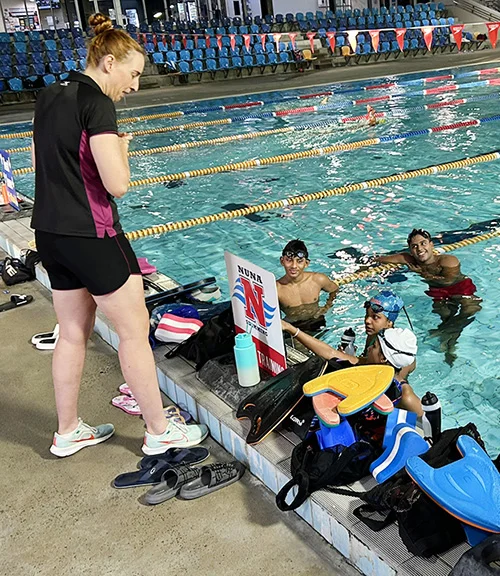Features
The digital divide: AI and its implications for higher education in Sri Lanka

 by Harshana Rambukwella
by Harshana Rambukwella
(formerly Open University of Sri Lanka)
The ‘digital divide’ and AIs
The term ‘digital divide’ emerged in the 1990s in the US to describe regional and class-based inequities in access to information technology (ICT) resources and later came to signify such inequities on a global scale. Such inequities range from access to devices, access to the internet, the speed and quality of internet access and the uneven spread of what is called ‘digital literacy’ – or the ability to use ICTs. During the COVID-19 pandemic and physical closure of schools and universities we witnessed the stark realities of this divide within Sri Lanka and how it amplified pre-existing inequities in the country’s education system. Students from disadvantaged social backgrounds – rural students, students from urban poor backgrounds and students in plantation communities, etc. – struggled with the shift to online learning. Policymakers and politicians attempted to provide a positive spin on this tragic reality. However, with students climbing trees, scrambling up hills in search of better mobile internet reception and teachers confounded and confused by the technology, the painful inequities of our education system were evident. The Sri Lankan experience ran counter to the hype about how technology can ‘disrupt’ conventional educational structures and potentially ‘democratize’ pedagogical practice. Technology’s ability to ‘disrupt’ or level the education playing field remains heavily overdetermined by social, class and regional inequalities and therefore claims about pedagogical innovation through technology need to be considered with caution.
In this piece I want to reflect on the implications of Generative Artificial Intelligence, sometimes referred to as chatbots, for higher education in Sri Lanka. Given the multidimensional crisis confronting higher education in the country – dwindling state resources for state universities, inability to attract and retain qualified staff, dysfunctional governance, just to name a few – something like AI has received relatively less attention. However, AI is fast becoming a reality across education systems across the world and this is no different in Sri Lanka. One of the ironies of AI’s rapid infiltration of education systems is that it can seemingly offer a progressive ‘disruption’ of education systems but in reality, have the opposite effect. In fact, the free access offered by AI (at least in its current iterations), the broadening of internet access, and their ease of use – requiring little or no specialized IT knowledge – seemingly offers ways of bridging the ‘digital divide’ I referred to above. But, as I attempt to illustrate below, AI might further amplify and exacerbate pre-existing inequities in education and very likely create new challenges that might further marginalize already disadvantaged learners.
AIs and equity in education
One area in which AI infiltration can have multiple equity-related implications in the Sri Lankan higher education context is in the use of English as a medium of instruction. Many private higher education institutions in the country already use English as the medium of instruction across all disciplines because of the social capital associated with the language and the flawed and reductive correlation established between English and ‘graduate employability’. Normalizing this flawed discourse further, state universities are also now attempting to institute English medium instruction – even in social sciences and humanities disciplines, which unlike the sciences, have traditionally used local languages. The standard of English among faculty and students in all disciplines, but more so in humanities and social sciences, is grossly inadequate for such a shift in medium in instruction and will therefore inevitably result in what can only be described as a crisis. Within such a scenario one can see the immediate attraction of Generative AI because it will allow both faculty and students an easily accessible and easy to use tool that can generate curriculum content and a wide range of student assignments. However, the use of AI also requires a command of English. The quality of the AI output is heavily reliant on the quality of prompt you provide it and therefore both faculty and students who are more proficient in English will be at an advantage. They will also be at an advantage in reading and vetting the content produced by the AI – whereas someone with low proficiency in English will be forced to use the content as is.
In addition to this explicit link between English, AI and equity there are a number of other issues that can have significant implications for higher education – if AI adoption becomes a widespread practice. AIs operate on what are called Large Language Models or LLMs. These are essentially massive databases of text (or what linguists would call corpora) which the AIs draw upon to produce content. It might be helpful here to illustrate how AIs produce seemingly ‘new’ or ‘original’ content. When an AI is given a word or a series of words or a set of sentences as a prompt, it draws upon this vast database to calculate the probability of what words or sentences will follow the words and sentences a user provides in the prompt.
This probability, in turn, is based on the content of the databases that the AI has access to. When this process is scaled up millions or billions of times the content the AI produces looks ‘new’ though, in fact, it is mimicking patterns it has identified in the databases it is accessing. What this mimicry means though is any biases, prejudices or omissions present in the databases are also being reproduced and possibly being amplified. Given that a vast amount of the content on the internet (which is the main source of data for AIs) is in English and is ideologically Anglo, US or Eurocentric the AI output will also reproduce these biases. Since multilingual content on the internet — particularly when it comes to globally marginal languages like Sinhala or Tamil (though Tamil has a much larger presence) – is extremely limited, speakers of such language are particularly disadvantaged. This also means that AI can potentially skew academic production – both what faculty provide as curriculum and what students produce as assignments – in ways that silence or erase local specificities.
One can argue that this is already the case because even in the social sciences and the humanities knowledge production remains heavily Anglo-Euro-centric and academics and institutions in the global south are forced to rely on such ‘first world’ material. However, what most faculty do is adapt such material to local conditions and realities. For instance, when a Sri Lankan sociologist draws on the work of Pierre Bourdieu, there is almost an inevitable compulsion to ‘read’ Bourdieu in a way that makes sense for the Sri Lankan context – or at least one hopes that is the case! However, if such content is generated by AI, the very experiential world it draws on – not just the theory – will have little or nothing to do with the Sri Lankan context. One might argue that this is an extreme example, but I contend it can be a very real scenario in the neo-liberal higher education environment that is increasingly becoming the norm in the country. In this scenario both the teacher and student are in a transactional relationship where the teacher is a ‘service provider’ and the student a ‘customer’ and both are concerned with the ‘end product’ – a qualification – rather than the process (educating a mind). AI generated content in this context – which has the trappings of ‘proper’ academic output such as formatting, the right generic sentences, a structure that resembles an academic paper – but has little original or context-specific material will be tremendously attractive to both teacher and student. One can also imagine scenarios where students might write a prompt in Sinhala or Tamil translate it into English (using online translation tools) feed it into an AI and then retranslate the AI output back into the local language. Leaving aside the ethical dilemma of whose product this is, one can imagine how derivative such an output might be. I also believe this is not a far-fetched situation because I know anecdotally that such things are happening in universities in Sri Lanka already.
AI, the market and knowledge inequities
By way of conclusion, I want to reflect on how AI is deeply implicated in global capital, the commodification of education and the reproduction of inequities in global knowledge production. While AI has appeared in the guise of a disruptive technology, it is no accident that it is some of the world’s most powerful tech companies that are funding and driving AI innovation. The potential of AI to replace a wide range of white-collar jobs – even in the creative industries where automation was previously unimaginable – is now becoming clear. In education, as I have already mentioned, AI can easily accelerate and intensify the transactional nature of commodified education models – where students essentially ‘buy’ a qualifications. Given that Sri Lanka is also mulling things like student loans, as the state increasing divests itself from education, AI provides a complementary technological transformation of the higher education space. The heavy emphasis on digitalization in the controversial National Education Policy Framework (NEPF) can also be seen as part of this larger trend. AI will also most likely (though this is not a given) integrate Sri Lanka even more tightly into an uneven and inequitable knowledge economy, where in a dark irony much of the intellectual labour in building and ‘training’ these AIs will come from places like Sri Lanka but in time will also result in the loss of employment as the AIs reach a level of ‘maturity’ and ability to self-perpetuate. In addition to coding the actual AIs they also need ‘training’. A recent insidious example of this was how Open AI, the company behind ChatGPT, used cheap Kenyan IT labour (paid less than 2 US$ per hour) to label data considered ‘toxic’ (racist, hateful, SGBV content, etc.) so that ChatGPT could be trained to recognize such ‘toxic’ content. Reportedly, this experience left the Kenyan IT workers severely traumatized – a situation where workers in the global south now have to contend cleaning the first world’s digital garbage in addition to historically being the recipients of toxic industrial waste products.
The way AI is being ‘sold’ in higher education today is to regard it as a tool which is not a replacement for human labour but something that can potentially enhance human interaction – for instance, by freeing up faculty time from routine tasks by assisting with grading, developing rubrics and even developing curriculum content so that faculty have time for a deeper and richer engagement with students. But the industrial scale at which these technologies are infiltrating higher education suggests an altogether different reality. Particularly in education markets like Sri Lanka with weak regulation and oversight, where, for instance, highly dubious online instruction-based courses have proliferated post-pandemic, the attraction of substituting human labour with AIs for profit-driven education investors is obvious. At another more fundamental level AI is creating a situation where a kind of highly skewed ‘global subconscious’ – based on the flawed data which shapes these LLMs – might begin reproducing itself at scale if education institutions in the global south begin to rely more and more on these technologies. For Sri Lankan higher education this might seem a distant reality at the moment. But if the IMF-crafted austerity programme that is aggressively reshaping Sri Lankan society at the moment has taught us anything, it should be the power and reach of global capital – potentially accelerated and amplified by the industrial scale of AI.
(Kuppi is a politics and pedagogy happening on the margins of the lecture hall that parodies, subverts, and simultaneously reaffirms social hierarchies.)
Features
‘Silent Majority’ abandoned to Long-suffering in regional conflicts

 With reports emerging that India has attacked some ‘sites’ in Pakistan and Pakistan-administered Kashmir, the question could be posed whether the stage has just been set for yet another costly India-Pakistan military conflict. Sensible opinion in South Asia could only hope that wise counsel would sooner rather than later come to prevail on both sides of the divide and that they would draw back from the brink of full-scale war.
With reports emerging that India has attacked some ‘sites’ in Pakistan and Pakistan-administered Kashmir, the question could be posed whether the stage has just been set for yet another costly India-Pakistan military conflict. Sensible opinion in South Asia could only hope that wise counsel would sooner rather than later come to prevail on both sides of the divide and that they would draw back from the brink of full-scale war.
The states concerned ought to know fully well the possible wide-ranging weighty consequences of another regional conflict. It should be plain to see that it would benefit none in the two theatres of confrontation, most particularly the relevant publics or the ‘Silent Majority’.
In fact, in connection with the mentioned initial military attacks, the Pakistani side has gone on record that some civilian lives have been lost. Such losses could burgeon in the event of full scale hostilities. These costs could of course be staggering and unimaginable in the event the nuclear option is resorted to by the sides, going forward.
Accordingly, the hope of the peace-loving world-wide is likely to be that India and Pakistan would give negotiations a chance and resolve their differences peacefully. It would be in the best interests of the world for the champions of peace to join their voices to that of UN chief Antonio Guterres and call on the sides to negotiate an end to their differences.
The utter helplessness and misery of the people of the Gaza ought to drive home afresh the horrors of war. Currently the news is that the Gazans are literally starving to death. Food and other essentials provided by UN agencies are reportedly being prevented by Israel from getting to the hapless people of Gaza. So dire is their situation that concerned quarters are calling on the compassionate worldwide to provide the Gazans with food, water and other essentials voluntarily. This SOS would need to be heeded forthwith.
Accordingly, it could be inferred that most formal arrangements, including those that are generally under the purview of the UN, geared to providing emergency humanitarian assistance to the needy, have, for all intents and purposes, been rendered ineffective in the Gaza. The UN cannot be faulted for this state of things; rather, Israel should be held accountable in the main for it.
The matter of accountability is central to the dramatic slide into lawlessness the world has been experiencing over the past few decades. As could be seen, International Law is no longer fully applicable in the conflict and war zones of the world because it is not being adhered to by many state and non-state aggressors. That the UN is hapless in the face of such lawlessness is plain to see.
We have of course the Middle East wherein International Law has fallen silent for quite a while. How could it be otherwise, when Israeli aggressions are being winked at by the US, for which the policy of backing Israel is almost sacrosanct?
Moreover, under President Donald Trump, it is difficult to see the US changing policy course on the Middle East. Trump made vague promises of bringing peace to the region in the run-up to his reelection but has done nothing concrete by way of peace-making. Consequently, complete lawlessness prevails in the Middle East. US policy towards Israel counts as another example of how the self- interest of US central administrations blinds them to their international obligations, in this case Middle East peace.
However, the commentator could be criticized as being biased if he holds only Israel responsible for what has befallen the Middle East. It has been the position of this columnist that Israel’s security needs should be taken cognizance of by its state and non-state adversaries in the Middle East and acted upon if the basis is to be laid for a durable Middle East peace. Inasmuch as Palestinian statehood must be guaranteed, the same should be seen as applicable to Israel. The latter too enjoys the right to live in a secure state of its own, unopposed by its neighbours.
The Ukraine of today is also sad testimony to the ill consequences of powerful, aggressor states wantonly disregarding International Law and its obligations. Nothing could justify Russia in invading Ukraine and subjecting it to a condition of Longsuffering. Clearly, Ukraine’s sovereignty has been violated and such excesses go to the heart of the current state of ‘International Disorder’. Of course the same stricture applies to the US in relation to its military misadventures in Afghanistan and Iraq, to name just two such modern examples.
There is no ducking the fact, then, that civilian publics in the mentioned theatres of war and outside, are being subjected to the worst suffering as a consequence of the big powers’ self-aggrandizement schemes and military misadventures. Longsuffering becomes the tragic lot of the people who have nothing to do with such unbridled power ambitions.
One would not be exaggerating the case if he states that civilian publics count for almost nothing in the present ‘International Disorder’. Increasingly it is becoming evident that from the viewpoint of the big powers and authoritarian governments the people are of little or no importance. Considering that self-aggrandizement is of the paramount interest for the former the public interest is coming to be seen as inconsequential.
Consequently, not much of a case could be made currently for the once almost reverentially spoken of ‘Social Contract’. For, the public interest does not count for much in the scrambles for power among the major powers who are seen at the popular level as the principal history-makers.
It is in view of the above that much is expected of India. Today the latter is a ‘Swing State’ of the first importance. Besides being a major democracy, it is one of the world’s principal economic and military powers. It possesses abundant potential to help to put things right in international politics. If there is one state in Asia that could help in restoring respect for International Law, it is India.
Considering the above, India, one believes, is obliged to bear the responsibility of keeping South Asia free of any more long-running, wasting wars that could aggravate the material hardships and socio-economic blights of the region. Thus, India would need to consider it imperative to negotiating peace with Pakistan.
Features
Memorable happening … Down Under

 Under the Global-Ise Australia Advanced Sports Development Programme, a delegation of 15 swimmers from Lyceum International School, Wattala, had the remarkable opportunity to train and experience high-performance sports development in Melbourne, Australia.
Under the Global-Ise Australia Advanced Sports Development Programme, a delegation of 15 swimmers from Lyceum International School, Wattala, had the remarkable opportunity to train and experience high-performance sports development in Melbourne, Australia.
The 10-day programme was carefully curated to offer intensive training, educational exposure, and cultural experiences for the young athletes.
The swimmers underwent specialised training through Swimming Victoria’s elite programme, held at some of Melbourne’s premier aquatic facilities.

Visit to Victorian Parliament
Each day began as early as 5:00 a.m. and continued until 7:00 p.m., ensuring a rigorous and enriching schedule that mirrored the standards of international competitive swimming.
Beyond training, the programme offered a wide array of experiences to broaden the students’ horizons.

Morning training
The tour group explored iconic landmarks such as the Victorian Parliament and the Melbourne Cricket Ground (MCG), and enjoyed shopping at Chadstone – The Fashion Capital. They also experienced the natural beauty of Victoria with visits to Yarra Valley Chocolaterie & Ice Creamery, and Cardinia Reservoir Park, where they observed kangaroos in their natural habitat.
An academic highlight of the tour was the group’s exclusive visits to three of Australia’s leading universities: the University of Melbourne, Monash University, and Deakin University. These visits aimed to inspire students and showcase the vast educational opportunities available in Australia.

Checking out the scene at Yarra Valley Chocolaterie & Ice Creamery
As part of the cultural immersion, Global-Ise hosted a traditional Australian BBQ at the Tim Neville Arboretum in Ferntree Gully. The students also enjoyed a variety of diverse culinary experiences each evening, further enriching their understanding of local and international food cultures.
The tour concluded with a celebratory dinner at the Spicy Wicket Restaurant, where each participant received a presentation in recognition of their involvement.

Enjoying an Aussie BBQ for lunch
The evening was made especially memorable by the presence of Pradeepa Saram, Consul General of Sri Lanka in Victoria.
Global-Ise Management—Ken Jacobs, Johann Jayasinha, and Dr Luckmika Perera (Consultant from the University of Melbourne)—did a magnificent job in planning and the execution of the advanced sports programme.

Coaches from Sri Lanka presenting a plaque to Global-Ise Management team
Ken Jacobs (centre), Johann Jayasinha, and Dr Luckmika Perera (on the right
Features
Bright, Smooth Skin

 Hi! How’s the beauty scene keeping with you?
Hi! How’s the beauty scene keeping with you?
Phew, this heat is awful but there is nothing that we can do about it.
However, there are ways and means to take care of your skin and I will do my best to help you in every way I can.
Well, this week, let’s go for a Bright, Smooth Skin.
Gram flour (also known as besan) is a traditional skincare ingredient known for its:
* Natural exfoliating properties.
* Ability to absorb excess oil.
* Gentle brightening and tan-removal effects.
* Suitability for all skin types, especially oily and acne-prone skin.
You will need 01–02 tablespoons gram flour (besan) and rose water, or raw milk, to make a paste.
You could add the following two as optional add-ins: A pinch of turmeric (for extra glow), and a few drops of lemon juice (for oily skin and pigmentation)
Add the gram flour to a small bowl and mix in the rose water (for oily/sensitive skin) or raw milk (for dry skin) slowly.
Stir well to make a smooth, spreadable paste—not too thick, not too runny.
Now apply this mixture, evenly, to your damp face and neck, and let it sit for 5–10 minutes (don’t let it dry completely if you have dry skin).
Gently massage in circular motions using wet fingers—this helps exfoliate.
Rinse off with lukewarm water, and then pat your skin dry.
Use it 02–03 times a week for best results.
Skin Benefits:
* Removes dirt, sweat, and oil without stripping natural moisture.
* Gently exfoliates dead skin cells, revealing smoother skin.
* Brightens the complexion and fades mild tanning.
* Helps clear clogged pores and reduce pimples.
* Leaves skin fresh and glowing—perfect for humid climates.
-

 News7 days ago
News7 days agoRanil’s Chief Security Officer transferred to KKS
-

 Opinion5 days ago
Opinion5 days agoRemembering Dr. Samuel Mathew: A Heart that Healed Countless Lives
-

 Business3 days ago
Business3 days agoAitken Spence Travels continues its leadership as the only Travelife-Certified DMC in Sri Lanka
-

 Business3 days ago
Business3 days agoLinearSix and InsureMO® expand partnership
-

 Latest News2 days ago
Latest News2 days agoNPP win Maharagama Urban Council
-

 Business7 days ago
Business7 days agoCCPI in April 2025 signals a further easing of deflationary conditions
-

 Features5 days ago
Features5 days agoTrump’s economic missiles are boomeranging
-

 Features7 days ago
Features7 days agoExpensive to die; worship fervour eclipses piety












